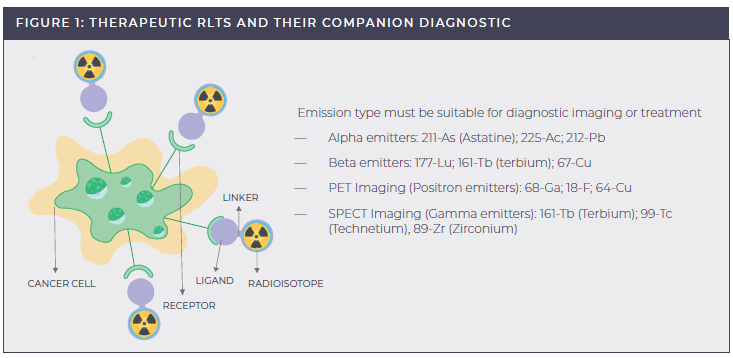Key trends driving the emergence of targeted radiotherapeutics as an oncology therapeutic pillar
Research Contributors: Andris Ortmanis, Sr. Director & Anita Zutshi, Associate Director
This is a preview of our latest whitepaper. Be sure to download the full piece below.
Targeted radiopharmaceuticals are transforming cancer treatment by enabling systemically delivered radiotherapy to be integrated into diagnostic workup algorithms and personalized medicine treatment strategies across a range of tumors.
The FDA and EMA have approved two radioligand therapies for the treatment of cancer, LUTATHERA (GEP-NETs) and PLUVICTO (mCRPC). Both agents were acquired by market leader Novartis while in pivotal development and delivered global revenue of $1.8B in 2023. Novartis projects PLUVICTO alone has >$3B global market potential, which underscores the commercial and therapeutic impact of the expanding pipeline of radioligand therapeutics.
Targeted radiopharmaceuticals may become the ultimate focal therapy by enabling the delivery of lethal radiation to malignant tissue – with minimal healthy tissue involvement. The specific structure of a radiopharmaceutical depends on the intended application but consists of a radioisotope payload associated with a small molecule ligand or monoclonal antibody to target malignant tissue.

Figure 1: Therapeutic RLTs and their companion diagnostic counterparts generally only differ in their associated radioisotopes, with either beta (e.g. 177-Lu, 67-Cu, 131-I) or alpha (e.g. 225-Ac, 227-Th) emitters used therapeutically, and positron-emitting radioisotopes (e.g. 68-Ga, 18-F) used for diagnostic purposes. This enables the personalized radiotherapy to be delivered with the same construct that was used to visualize and characterize the tumor diagnostically.

Jump to a slide with the slide dots.
 Mariah Hanley
Mariah Hanley
US vaccines trends and strategies for manufacturers
Discover insights into the evolving US vaccine landscape, trends, and strategic imperatives for successful novel vaccine launches. Download now!
Read more Mariah Hanley
Mariah Hanley
Recent Trends in Rare Diseases
Putnam experts share observations on recent global trends in the rare disease space and recommend strategies to maximize opportunities.
Read more Karan Raje
Karan Raje
Simplify to amplify: “Declutter” your current Customer Engagement approach to maximize value
Learn how Putnam reviewed the paths took by five prominent biotech companies to establish itself as a successful commercial-stage organization.
Read more
